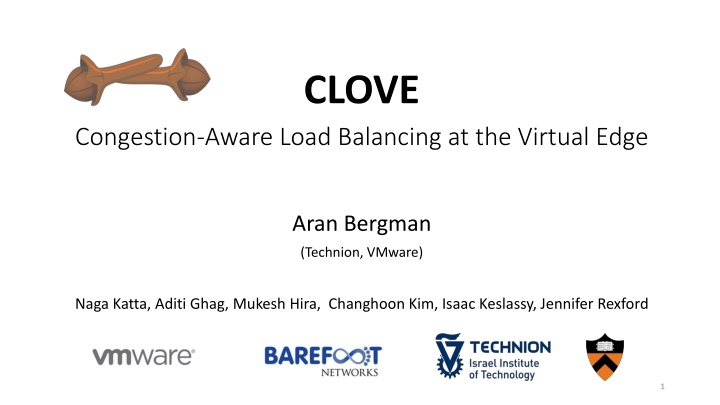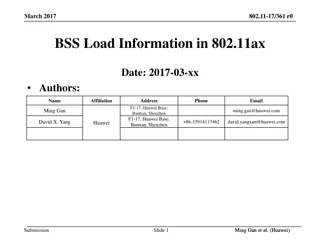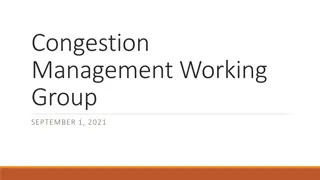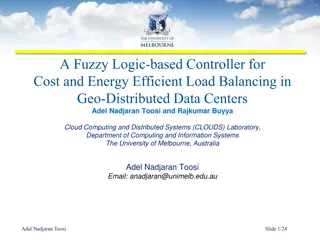Congestion-Aware Load Balancing at the Virtual Edge
Explore the CLOVE framework, a congestion-aware load balancing approach at the virtual edge, addressing issues faced by previously proposed schemes. It operates in data centers using ECMP routing, with a focus on vSwitch implementations for efficient traffic distribution.
Download Presentation

Please find below an Image/Link to download the presentation.
The content on the website is provided AS IS for your information and personal use only. It may not be sold, licensed, or shared on other websites without obtaining consent from the author.If you encounter any issues during the download, it is possible that the publisher has removed the file from their server.
You are allowed to download the files provided on this website for personal or commercial use, subject to the condition that they are used lawfully. All files are the property of their respective owners.
The content on the website is provided AS IS for your information and personal use only. It may not be sold, licensed, or shared on other websites without obtaining consent from the author.
E N D
Presentation Transcript
CLOVE Congestion-Aware Load Balancing at the Virtual Edge Aran Bergman (Technion, VMware) Naga Katta, Aditi Ghag, Mukesh Hira, Changhoon Kim, Isaac Keslassy, Jennifer Rexford 1
Data center load balancing today src,dst IP + src,dst port + protocol Equal-Cost Multi-Path (ECMP) routing: Path(packet) = hash(packet s 5-tuple) Spine Switches Coarse-grained Elephant Hash collisions . . . . . . Leaf Switches Congestion-oblivious Servers 2
Previously proposed load balancing schemes vSwitch vSwitch Hypervisors 3
Previously proposed load balancing schemes Centralized load balancing Hedera, Fastpass, MicroTE, SWAN Central Controller Control-driven feedback Slow reaction time Routes computation overhead Scalability Issues vSwitch vSwitch Hypervisors 4
Previously proposed load balancing schemes In-network load balancing CONGA, HULA, LetFlow, DRILL Needs custom ASIC data center fabric High capital cost Controller Involvement may still be vSwitch vSwitch required Hypervisors 5
Previously proposed load balancing schemes End-host load balancing Presto Congestion Oblivious Controller intervention in case of topology asymmetry MPTCP Incast collapse Guest VM network stack changes Hermes (SIGCOMM 17) Concurrent effort vSwitch vSwitch Hypervisors 6
vSwitch as the sweet spot Easy to implement No Switch HW changes Spine switches No guest VM changes Leaf switches vSwitch vSwitch 7
CLOVE assumptions Clove operates over a DC Overlay e.g., Stateless Transport Tunneling (STT) Spine switches Network switches with ECMP using 5-tuple Outer transport header is used for ECMP traffic distribution Leaf switches Eth IP TCP Overlay vSwitch vSwitch Payload Eth IP 8
CLOVE in 1 slide CLOVE in 1 slide Path discovery using traceroute probes Load-balancing flowlets [FLARE 05] vSwitch switching between paths based on RTT-scale feedback Explicit Congestion Notification - ECN In-band Network Telemetry - INT 9
Path Discovery Load balancing flowlets vSwitch Load balancing Outer transport source port (with ECMP) maps to network path Standard ECMP in the physical network Hypervisor learns source port to path mapping Dst SPort H2 P1 H2 P2 vSwitch vSwitch H2 P3 H2 P4 ECMP-based source routing H2 Hypervisor H1 H1 Hypervisor H2 10
Load balancing flowlets Scheme 1: Edge-Flowlet Path Discovery vSwitch Load balancing Dst SPort vSwitch vSwitch H2 P1 H2 P2 Flowlet gap H2 P3 H2 H1 H2 P4 11
vSwitch Load balancing Scheme2: CLOVE-ECN Load balancing flowlets Path Discovery Congestion-aware balancing based on ECN feedback 2. Switches mark ECN on data packets Data 4. Return packet carries ECN and src port for Path weight table 1. Src vSwitch detects and forwards flowlets Dst Dst SPort SPort Wt Wt 3. Dst vSwitch relays ECN and src port to src vSwitch H2 H2 P1 P1 0.25 0.1 Hypervisor H2 forward path Hypervisor H1 vSwitch vSwitch H2 H2 P2 P2 0.25 0.3 H2 H2 P3 P3 0.25 0.3 5. Src vSwitch adjusts path weights for the src port H2 H2 P4 P4 0.25 0.3 12
vSwitch Load balancing Scheme 3: CLOVE-INT Path Discovery Load balancing flowlets Utilization-aware balancing based on INT feedback 2. Switches add requested link utilization Data 1. Src vSwitch adds INT instructions to flowlets 4. Return packet carries path utilization for 3. Dst vSwitch relays path utilization and src port to src vSwitch Hypervisor H1 Hypervisor H2 forward path vSwitch vSwitch Dst SPort Util 5. Src vSwitch updates path utilizations H2 P1 40 H2 P2 30 H2 P3 50 6. Src vSwitch forwards flowlets on least utilized paths H2 P4 10 13
Performance evaluation setup Asymmetric Setup Spine1 Spine2 2-tier leaf-spine symmetric topology Web Search Workload Client on Leaf1 <-> server on Leaf2 4 x 40 Gbps Measure Average Flow Completion Leaf1 Leaf2 Time (FCT) 16 x 10 Gbps Compare Edge-Flowlet and Clove-ECN 16 Clients 16 Servers to ECMP, MPTCP and Presto 14
Symmetric topology Better 1.8x 2.5x 15
Asymmetric topology Better 12x 5x 16
Incast Workload Better CLOVE-ECN outperforms MPTCP on Incast Workloads 17
NS2 Simulation with CONGA Asymmetric Better 3x lower FCT than ECMP 1.2x higher FCT than CONGA CLOVE-ECN captures 80% of the performance gain between ECMP and CONGA 18
CLOVE highlights Captures 80% of the performance gain of CONGA No changes to network hardware, VMs, applications Adapts to asymmetry within the data plane Scalable due to distributed state 19
THANK YOU Questions? 20
Parameter Sweeping Empirical values for (flowlet-threshold, ECN-threshold) are 1RTT, 20pkts 22























